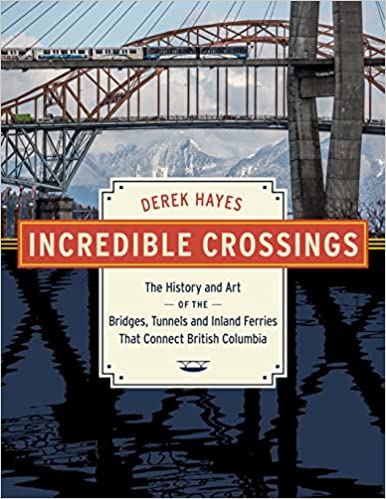
Incredible Crossings: The History and Art of the Bridges, Tunnels and Ferries That Connect British Columbia
Review By Frank Leonard
May 16, 2023
BC Studies no. 217 Spring 2023 | p. 131-132
In his introduction to Incredible Crossings: The History and Art of the Bridges, Tunnels and Ferries That Connect British Columbia, Derek Hayes offers a revealing explanation of the book’s origin. After Covid had blocked a trip to Japan that was part of a project concerning high-speed railways, the author instead “decided to put my collection of artistic-type photos together with my work as a historian and voilà – a book covering both the history of bridges and images of them as art” (7).
What follows is a ramble across and beside some 280 bridges, approximately one-tenth of the province’s official tally, as well as a handful of tunnels. Since bridges within driving distance of the author’s base in White Rock offered more opportunity to take photos, the selection of structures treated in detail is skewed toward the lower mainland. For several spans Hayes creates a brief foundation of text on which he lays a substructure of historical maps and construction photos, buttressed with informative captions. He then mounts a superstructure of contemporary photos, frequently in colour, of elements of the bridge from pier to tower, including graffiti. This format can enhance an examination of the creation and replacement of several bridges at the same site, such as the Granville Street Bridge, where the current structure is the third (32-39), and adjacent spans built over time for different purposes, such as the New Westminster trio of rail, road, and skytrain bridges (74-87).
The episodic presentation creates some difficulties, however. The book lacks a schematic diagram near the outset that identifies bridge components and briefly explains how a structure balances the forces of compression and tension. Readers without an engineering background must resort to the internet, as the author recommends (8), to follow his use of technical terms. There is little sense of the evolution of bridge building in the province beyond the several changes in major construction material from timber to steel and prestressed concrete. Did the material changes lead to new bridge designs? A table that compares load capacity between selected bridges, such as the CPR timber railway bridges of the 1880s and the Grand Trunk Pacific steel railway bridges completed a generation later, or the first and second Port Mann bridges, completed in 1964 and 2012, respectively, would suggest a reason for both material and design changes.
Hayes devotes pages to inland ferries and some tunnels, presumably because they are also “crossings.” Since the author excluded coastal ferries on grounds of space (308), why include inland ferries? Four tunnels are discussed at some length, but only the Massey Tunnel offers the combination of historical photos and maps with a series of admittedly underwhelming contemporary images that Hayes uses to good effect in his treatment of several bridges (58-61). Perhaps most surprising in a book created by the author of many historical atlases is the absence of a key map that could locate each structure listed in the alphabetical Bridge Finder (312-13), were each item to be simply designated with a number.
With small blocks of text and large striking photographs, this work might be described as a coffee table book. It is more – a largely successful initial foray into a fascinating, complex topic.
Publication Information
Hayes, Derek. Incredible Crossings: The History and Art of the Bridges, Tunnels and Ferries That Connect British Columbia. Madeira Park, BC: Harbour Publishing, 2022. 320 pp. $46.95 hardcover.
